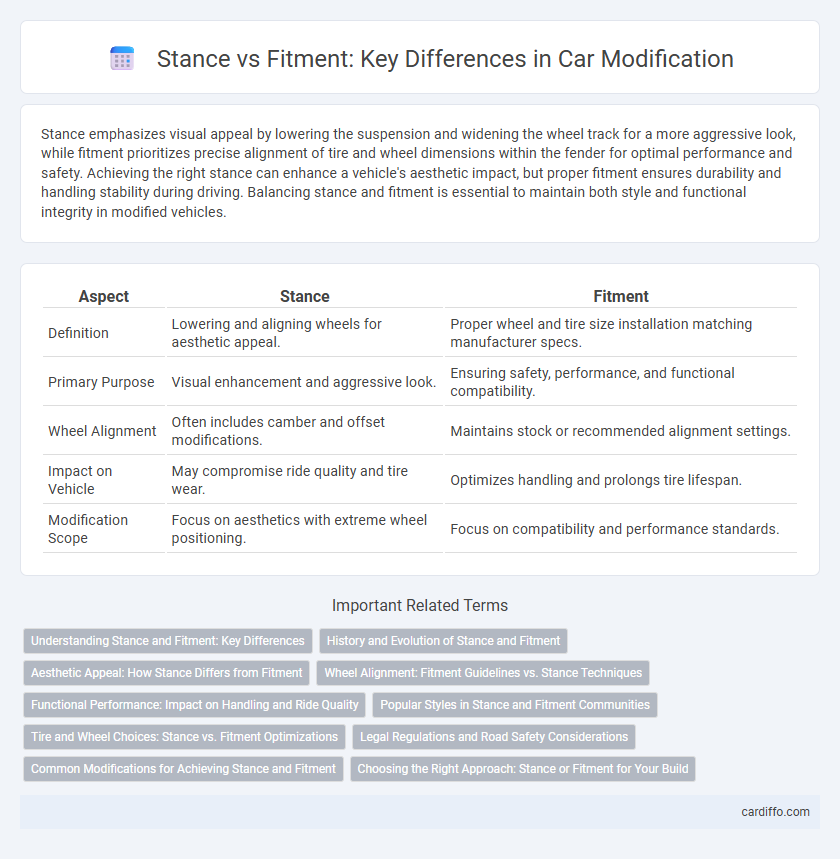Stance emphasizes visual appeal by lowering the suspension and widening the wheel track for a more aggressive look, while fitment prioritizes precise alignment of tire and wheel dimensions within the fender for optimal performance and safety. Achieving the right stance can enhance a vehicle's aesthetic impact, but proper fitment ensures durability and handling stability during driving. Balancing stance and fitment is essential to maintain both style and functional integrity in modified vehicles.
Table of Comparison
| Aspect | Stance | Fitment |
|---|---|---|
| Definition | Lowering and aligning wheels for aesthetic appeal. | Proper wheel and tire size installation matching manufacturer specs. |
| Primary Purpose | Visual enhancement and aggressive look. | Ensuring safety, performance, and functional compatibility. |
| Wheel Alignment | Often includes camber and offset modifications. | Maintains stock or recommended alignment settings. |
| Impact on Vehicle | May compromise ride quality and tire wear. | Optimizes handling and prolongs tire lifespan. |
| Modification Scope | Focus on aesthetics with extreme wheel positioning. | Focus on compatibility and performance standards. |
Understanding Stance and Fitment: Key Differences
Stance refers to the overall visual posture and aesthetic appeal of a vehicle achieved through wheel alignment, suspension adjustments, and tire selection, emphasizing low and wide setups for an aggressive look. Fitment focuses on the precise measurement and compatibility of wheels and tires with the vehicle's specifications, ensuring proper clearance without rubbing or interference. Understanding the distinction between stance and fitment helps achieve both style and functionality in automotive modification.
History and Evolution of Stance and Fitment
Stance and fitment have evolved significantly since their emergence in automotive culture during the early 2000s, with origins traced back to the Japanese VIP car scene and European Euro tuning movements. Initially focused on aesthetic appeal through lowered suspension and aggressive wheel offsets, both stance and fitment have incorporated advancements in suspension technology and wheel design to balance appearance with drivability. The evolution reflects a shift from purely visual modifications to a more integrated approach emphasizing performance, safety, and style within the modification community.
Aesthetic Appeal: How Stance Differs from Fitment
Stance enhances a vehicle's aesthetic appeal by emphasizing aggressive wheel positioning and lowered suspension, creating a unique visual presence distinct from traditional fitment focused on performance metrics. Unlike fitment, which prioritizes optimal tire size, clearance, and handling, stance centers on achieving a flush or cambered wheel look that complements the car's style. This stylistic approach transforms the vehicle's profile, making stance a popular choice for enthusiasts seeking personalized and eye-catching modifications.
Wheel Alignment: Fitment Guidelines vs. Stance Techniques
Wheel alignment plays a crucial role in ensuring both proper fitment and desired stance, balancing performance and aesthetics effectively. Fitment guidelines prioritize precise tire-to-fender clearance and suspension geometry to maintain safety and handling, while stance techniques often push alignment angles like camber and toe for aggressive visual appeal. Understanding the trade-offs between functional alignment and stylistic stance modifications helps optimize wheel setup for intended vehicle use.
Functional Performance: Impact on Handling and Ride Quality
Stance modifications primarily influence a vehicle's aesthetic and wheel alignment, often reducing suspension travel and negatively affecting handling precision and ride comfort. Fitment focuses on ensuring compatible wheel and tire sizes that maintain optimal contact patch and suspension geometry, preserving or enhancing functional performance. Proper fitment supports balanced handling dynamics and ride quality, whereas improper stance can lead to compromised traction and increased body roll.
Popular Styles in Stance and Fitment Communities
Popular styles in stance and fitment communities emphasize achieving a unique balance between aggressive wheel fitment and aesthetic appeal, often featuring extreme camber angles and flush tire-to-fender alignment. Stance enthusiasts prioritize lowered suspensions and wide wheels for a dramatic visual impact, while fitment focuses on precise measurements and tire stretching to optimize handling and appearance. Both communities celebrate creativity and individuality, driving innovation in aftermarket body kits, wheel offsets, and suspension setups.
Tire and Wheel Choices: Stance vs. Fitment Optimizations
Tire and wheel choices play a crucial role in balancing stance and fitment optimizations for modified vehicles. Stance focuses on achieving an aggressive, flush appearance by adjusting wheel offset, tire stretch, and suspension height, often prioritizing aesthetics over performance. Fitment emphasizes proper tire size, wheel width, and clearance to ensure optimal handling, safety, and compatibility with suspension components.
Legal Regulations and Road Safety Considerations
Modification stance and fitment require strict adherence to legal regulations to ensure compliance with vehicle standards and avoid penalties. Road safety considerations prioritize proper fitment to maintain vehicle stability, handling, and overall safety on public roads. Non-compliant modifications can lead to increased accident risks and legal liabilities.
Common Modifications for Achieving Stance and Fitment
Common modifications for achieving stance and fitment include adjusting suspension components like coilovers or air suspension to alter ride height and improve wheel alignment. Wheel fitment enhancements often involve selecting appropriate wheel offsets, widths, and tire sizes to ensure optimal clearance and aesthetic appeal. These modifications collectively enhance the vehicle's appearance and handling without compromising safety or drivability.
Choosing the Right Approach: Stance or Fitment for Your Build
Selecting the ideal approach between stance and fitment for your build hinges on your vehicle's purpose and aesthetics. Stance prioritizes aggressive wheel positioning and extreme camber for visual impact, while fitment emphasizes precise wheel size, offset, and clearance to ensure optimal performance and drivability. Understanding the trade-offs between the two allows for a balanced customization that aligns with both style and functionality goals.
stance vs fitment Infographic

 cardiffo.com
cardiffo.com